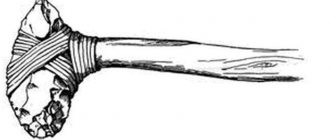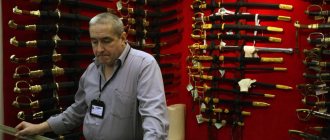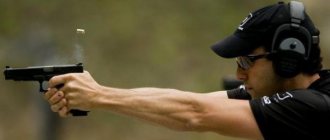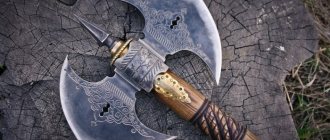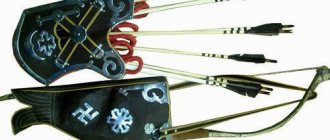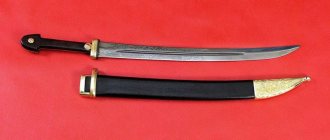In the Middle Ages, people often entered the battlefield who did not have a noble title, knightly armor or money to purchase them. But each warrior needed to arm himself in order to be able to decide the outcome of any fight in his favor.
Obviously, the weapon of an ordinary warrior could not be very expensive, so it was created from improvised means that are available in any village. This is how a combat flail appeared, accessible to any peasant, which did not require special skills in manufacturing and use. The combat flail itself was a stick and a metal or stone weight fastened to it with straps or a chain; its weight did not exceed two kilograms.
History of origin
It is impossible to clearly track the time of the appearance of the flail. Herodotus also pointed out in his writings that in the 6th-4th centuries BC the Scythians (they lived in the south of Eastern Europe and Asia up to Mongolia) used whips as weapons in battle. Thus, before the flail appeared, it remained to attach a bone or stone weight to the end of the whip.
It has been established for certain by historians and archaeologists that the Eastern European variants of the flail originated from its various Khazar variants. Among these nomadic tribes who lived in the lower and middle reaches of the Volga, the use of combat flails was noted in the 4th-9th centuries AD.
This weapon was very suitable for the light cavalry of the nomads and could well be used along with the saber as a first strike weapon.
Since nomads constantly attacked neighboring states, it is not surprising that the flail spread in the 10th century in Ancient Rus', which was constantly subject to raids from the south.
Residents of Rus' appreciated this first strike weapon, and soon it began to be used as an auxiliary weapon for horsemen and foot warriors. Of course, the technique of working with a flail was changed in accordance with the characteristics of the fighting of our ancient ancestors.
The appearance of these bladed weapons in Central Europe is associated not only with the raids of nomads, although there were plenty of them, but also with the migration of peoples during the Middle Ages in general. Here we should recall the resettlement of the Volga Bulgars to the territory of modern Bulgaria, and the Hungarians from the Urals to the territory of modern Hungary.
These peoples were familiar with the technique of fighting with flails, and in their new place of residence they remained faithful to their previous traditions. Given the short European distances, these weapons quickly spread, first across neighboring countries, and then throughout Europe.
Here it should be remembered that the European armies of the 10th-15th centuries had armored and invulnerable knights as their main striking force.
It is clear that neither a bone nor a stone flail can cause much damage even to a knight’s helmet, so the striking part became metal.
The pinnacle of the evolution of this weapon in Europe was the appearance of the morning star (morning star), in which the striking part was a small ball with spikes.
One should not think that such weapons were common only in Europe - since the idea of attaching a striking part to a handle on a belt or chain is very simple, various versions of these weapons appeared almost everywhere where people lived.
It is worth noting the difference between weapons created from tools of production, such as a flail. Combat flails (nunchucks), unlike flails, had a shortened flexible coupling and a longer handle and striking part, which radically changed the fighting technique.
Extinguished
The design of the extinguisher differs little from the hanging flail; but its belt ends in a loop that is easy to grab, allowing it to be thrown
. Thus, the extinguisher combines the features of an obtrusive flail and... a bola (we talked about it in the article on slings). True, the main effect of the suppression was still impactful, not confusing.
There were extinguishers with a suspension of several meters; These could be used as a regular sling (if you wrap the pendant around your hand), or they could be thrown around - and then pulled back out like a harpoon. However, the use of such weapons requires very unusual conditions.
The closest modern relative of the extinguisher is the sports throwing hammer; they are structured almost identically. True, the hammer is perhaps heavier: 7 kg. By the way, the range record (Yuri Sedykh, 1986) is 86 meters
; evaluate the range of the weapon...
A robber's stun projectile is sometimes called extinguisher - a bag of sand or shot on a short rope (in English - sap).
Manufacturing materials and device
The flail is a percussion-crushing weapon consisting of a striking part, suspended on a flexible belt from the handle or without it.
A variety of materials were used for manufacturing; this is an extremely affordable weapon in terms of material; it is not necessary to use high-quality steel for the striking part; it is quite possible to use improvised stones or bone.
Only morningsterns have some variety in appearance - this weapon was often used as an additional weapon by knightly cavalry and therefore differed for the better from the weapons of commoners.
Since the device of the flail is very simple, we will reduce it to one list:
- lanyard or extinguisher - an additional device for comfortable grip into which the hand is threaded. The material used was animal skin;
- handle (handle) - a device for gripping, the most common version was made for gripping with one hand, but there were also those that allowed you to work with both one and two hands. The most popular material was wood, but there were also metal ones. Often, for ease of carrying, flails were made without a handle; in this case, it was replaced by a damper - a loop into which the hand was threaded;
- connecting link (belt) - a flexible part designed to connect the handle with the striking part. There are not many options for materials: rope, leather belt, metal chain;
- flail (weight) - the beating part of the weapon, made of bone, stone, various metals, and occasionally wood was used. Often the load had convex spikes or ribs to increase the traumatic effect. In addition, the morning stars used by nobles were often decorated with family coats of arms and engraving.
Edged weapon flail: origin
The hand is a contact flexible-jointed weapon with a shock-crushing action. The design involves a load (weight, or beater), connected to the flail (handle) using a suspension.
In the design familiar to contemporaries, the weapon appeared after the 13th century, although the first information about it dates back to the 11th century. Weights on chains were used by knights in England and Germany during the Middle Ages, and by Italians during the Crusades. The Muslim army of Salah ad-Din and even the Japanese samurai had similar models.
Interesting! Kisten is a Slavic name because the weapon was worn on the hand. The Turks called it “kistan”, or stick.
Tactical and technical characteristics of the flail
In the usual combat version, the total length of the weapon was 45-55 cm. The flail consisted of a striking part - a beater, which could be of different designs. The stick or handle was usually made of wood. For noble warriors, it was customary to decorate the handle with various metal parts, giving the weapon a special value. The handle could be covered with leather for a comfortable grip. At the end there was a leather loop through which the hand was fixed to the wrist.
In medieval Europe, where there were better technical conditions for the manufacture of metal edged weapons, various models of flails appeared. The knights preferred to have a morning star, which had a metal beater with steel spikes. A blow to steel armor with such an object could be fatal to the enemy. The spikes easily pierced armor and helmets. Among the warriors who owned these weapons, they adhered to the following principle - one blow - one death.
The German morning star or flail, which began to appear in the arsenal of private feudal armies, was made quite primitively and crudely. Only with the beginning of the Crusades, when an unspoken competition arose between noble knights in the quality of combat equipment, more noble examples of these weapons appeared. The handle was initially missing. The chain with the weight was simply put on a wooden stick if necessary. In some versions, at the end of the chain there was a special hook - a bracket on which some kind of load could be fixed as a beater.
The noble cavalry, which preferred to show off in front of each other, introduced its own innovations to combat equipment. Weapons become more sophisticated. Particular emphasis is placed on the appearance of the weapon. The flail handles take on a more convenient shape for gripping, with a square or oval cross-section. For a warrior in the thick of hand-to-hand combat, it was important not to let go of the weapon at a crucial moment. For more effective use of edged weapons in combat, the weight standards of the striking part begin to be taken into account during manufacturing.
For example: A lead beater the size of a walnut and weighing 200-300 g when hit during a backswing produced a force of 16 kg per cm2. One can only imagine what the warrior felt when receiving such a blow.
It is not advisable to make a larger weight. More weight entails more effort. The inertia of a heavy beat created during a swing can only harm the warrior himself. In addition, a brush with a large weight was inconvenient in battle. There might not have been time for a full swing. The greatest effect was produced by short and sharp wrist blows.
Kusari-gama
Kusari-gama.
There are many strange things among eastern weapons, but the kusari-gama stands out even among this series. It consists of three parts: a sickle-kama, a chain is attached to it by the handle, and at the other end there is a steel apple.
Many other eastern flails are peasant, secret weapons, but not the kusari-gama: although it is made of a sickle-kama, it is impossible to pass it off as a peaceful instrument. There is a whole martial art called kusari-gama, and, according to some sources, it was a wonderful counterbalance to the most popular types of samurai weapons - the sword and the yari spear. There is a legend about the famous master Kusari-gama, who defeated many swordsmen until one of them lured him into a bamboo grove; among the dense growth, as already mentioned, you can’t wave a flail.
However, Eastern wisdom is a topic for a separate article (and more than one), and probably not mine: on the shaky soil of the shores of the Yellow Sea, I don’t feel too confident.
Different types of weapons and operating principles
In a combat situation, a warrior must always adequately assess the strength and power of his weapon. Using a melee weapon inappropriately can have fatal consequences, so if the enemy has a superior weapon, a spear or a two-handed sword, the flail will be useless. It was convenient for riders to use such weapons only during an equal fight or when attacking a weaker enemy.
There is a certain typology that distinguishes this edged weapon into the following types:
- the first type is a brush equipped with an elongated, ovoid-shaped bone weight. This type can be attributed to the early period when the first facts of combat use of weapons appeared (X-XII centuries);
- the second type is a shock-crushing weapon, equipped with copper or iron spherical weights. Both smooth and faceted beats are available. In this form, the flail appears in the arsenal of warriors at the end of the 12th and beginning of the 13th centuries;
- the third type is a flail or morning star, which has clear dimensions of a beater and a handle. Spikes or protrusions appear on a lead or iron weight, enhancing the damaging effect. This weapon has already been firmly included in the arsenal of warriors since the 13th century.
It should be noted that with the appearance of warriors clad in armor on the battlefield, the bone beater loses its combat significance. Riders are equipped with bladed weapons made from metal parts. Due to the metal beater, the force and concentration of the blow increases.
Combat techniques using weapons of this type are also being improved. Techniques are practiced in which the flail can cause maximum harm to the enemy. The first blow is the most important. Subsequent defense with this type of weapon is practically impossible. Even the presence of a hilt does not allow the warrior to successfully parry retaliatory strikes. A dangling chain with a heavy load becomes an obstacle to the stable position of the weapon in the hand. The main combat use of this weapon is its combination with a sword. A horseman who is good with both a sword and a flail can simply suppress his opponent with force. To attack, a brush is used, which allows you to strike the head and even the back of the enemy. The sword is designed for effective defense against retaliatory strikes.
However, this tactic is more suitable for knightly tournaments. In a real fight, a spear or battle ax is much more effective, not to mention swords. The flail was used extremely rarely, and it was also necessary to know how to use such a weapon.
Use in combat
The main factor in combat flails is the speed with which the blow is struck, therefore the striking technique used in battles implied a wrist blow with a short swing or without one at all.
The blow itself had to hit the enemy's head or body; it was even possible to hit his unprotected back (due to the presence of a rather long chain). This was due to the fact that the flail is a weapon of the first strike, and it was almost impossible to defend with it.
Even with a metal flail handle, it was almost impossible to repel a blow (no matter what weapon) due to the unpredictable behavior of this handle and the load.
The films beautifully show that with a flail or just a chain you can take away a sword or pike from an enemy. In practice, everything is not so clear. You can get wounded by your own flail.
In the nomadic armies, this weapon was successfully used in cavalry.
Light cavalrymen successfully used the flail as an additional weapon in the lands of Ancient Rus'. This is due to the difference in the history of Europe and the eastern part of Ancient Rus', to which the era of chivalry did not reach.
In Europe, in the Middle Ages, heavily armed knights on the battlefield, who relied on the force of the blow, and not on its speed, used the flail extremely rarely. Heavy ammunition did not allow for a quick wrist strike, and the weapon itself was considered a weapon of commoners.
The use of this weapon by knights was recorded only in cases when in battle he was deprived of his more familiar weapons - a sword, spear, battle axe, and this applies to the morning star, and not to the flail.
On the other hand, having a saber and a flail technique proven in battle, a lightly armed warrior penetrated the defense of a heavily armed shield-bearer. The low cost of production made it possible to easily and in a short time arm an army of rebel peasants or conscripted militias, since their weapons were non-combatant.
As one of the main types of weapons, the flail was used in European wars in only one army - and this was the army of the rebel Czechs under the leadership of first Jan Hus and then Jan Žižka.
It should be remembered what the Hussite camp was like - these were war carts placed in a circle, behind which the army was hiding.
When the enemy tried to break into the camp, each of the defenders had time for one blow. The Czech peasants with these weapons (which by that time had become similar to a morning star) were able to successfully go on the attack, literally mowing down a number of enemy soldiers at the first blow.
With the development of technology, edged weapons were increasingly replaced by firearms. This trend did not bypass flails, although their last use in battle was recorded during the First World War. But this was the improvisation of individual soldiers, and not generally accepted army practice.
The use of combat flails
In military history, flails were not often mentioned as the main weapon in battles. Their wide dissemination was due to the modern interpretation of history in medieval Europe. Especially in films, for the sake of entertainment, horsemen were depicted clad in knightly armor and waving spiked metal weights dangling from chains. In reality, such a picture was very rare.
Russian history knows about the massive combat use of flails. This was at a time when the northwestern principalities were opposed to the Teutonic Order. Russian militias, which included commoners and poor nobles, preferred to have spears, pikes and flails in their weapons. In direct clashes with German knights, Russian horsemen, as a rule, used spears and axes. Europeans actively used flails during the Crusades against the Hussites. It was the Hussites who were armed with everything they could get their hands on, including flails. In their hands, they looked like heavy steel flails, capable of not only knocking riders out of their saddles, but also crushing the first ranks of advancing enemies.
As soon as the first military clashes with the militia took place, the Czech nobility had to use flails as an auxiliary weapon. The impact parts were made heavier and equipped with additional spikes, and to improve flexibility, chain links began to be reduced. Everything was done to make the flails convenient for combat use.
The most legendary flail was a device called the “morning star”. It looked like a weapon with a large core on a chain that was all covered in long spikes. There were other types of flails with three beaters on chains, but they were made mainly for psychological effect. It was not possible to use such weapons in real combat. Such samples were mainly made to intimidate the enemy.
The combat use of flails cannot be compared with battle axes, spears and swords. However, as a cultural value they have earned their place in the historical heritage. It was not without reason that gunsmiths gave their creations special shapes. Whether the flails would have been useful in battle or not is unknown, but they would definitely have adorned the equipment of warriors with their presence.
How does the law relate to flails?
In the last century, brushes began to appear in a simplified version, which did not have a handle and were a weight on a chain, or a piece of watering hose with a large nut at the end. Such options became especially widely used in criminal disputes that began after the collapse of the Soviet Union.
Nowadays, the Federal Law “On Weapons” classifies the flail as a bladed weapon.
Its production, storage and use is illegal. But only forensic examination can determine the characteristics of a weapon, therefore, morningstars certified as souvenir weapons are not such.
But if the examination considers that the presented flail is a bladed weapon, its manufacture and storage will be punishable under Art. 223 of the Criminal Code of the Russian Federation.
What traces of the flail remain in literature and history?
The success of the use of the flail by the Hussites and German peasants during the German wars was reflected in Talhoffer’s treatise “Old Armament and the Art of Fighting,” published in 1459.
It, along with the morning star that came into use, recommended the use of its improved version with three small balls instead of one.
Another mention can be found in the treatise of Sigismund Herberstein, which described the morals and customs of medieval Muscovy.
Flails were also mentioned as one of the types of cavalry weapons, and they were required for protection even when Grand Duke Vasily III went hunting.
It stands o - a tactical knife, the creator of which is A. M. Kisten, a master of knife fighting of our time. But this is no longer relevant to our topic.
Double-headed flail
| Double-headed flail with one-sided fastening. |
And here is the double-headed flail, so beloved by game makers - and so unpopular in real life. Moreover, oddly enough, these chains were usually attached not to one side of the handle, but to different sides (therefore, of all the types of double weapons in D&D, only the dire flail - this very double-headed flail - and the staff are related to reality). Possession of such a flail requires very subtle technique, perhaps more cunning than with kusari-gama.
Variants with two or three heads on one side of the handle were found... occasionally
. We cannot say with certainty that they were ever used in combat. It is possible that they are the same ceremonial weapons as the two-handed sabers that were at one time used by the palace guards in several Central Asian cities.


